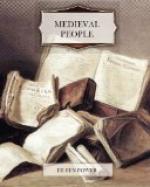How many of the literary critics, who chuckle over
her, know that she never ought to have got into the
Prologue at all? The Church was quite clear in
its mind that pilgrimages for nuns were to be discouraged.
As early as 791 a council had forbidden the practice
and in 1195 another at York decreed, ’In order
that the opportunity of wandering may be taken from
nuns we forbid them to take the path of pilgrimage.’
In 1318 an archbishop of York strictly forbade the
nuns of one convent to leave their house ’by
reason of any vow of pilgrimage which they might have
taken. If any had taken such vows she was to
say as many psalters as it would have taken days to
perform the pilgrimage so rashly vowed.’[22]
One has a melancholy vision of poor Madame Eglentyne
saying psalters interminably through her tretys nose,
instead of jogging along so gaily with her motley companions
and telling so prettily her tale of little St Hugh.
Such prohibitions might be multiplied from medieval
records; and indeed it is unnecessary to go further
than Chaucer to understand why it was that bishops
offered such strenuous opposition to pilgrimages for
nuns; one has only to remember some of the folk, in
whose company the prioress travelled and some of the
tales they told. If one could only be certain,
for instance, that she rode all the time with her
nun and her priests, or at least between the Knight
and the poor Parson of a town! But there were
also the Miller and the Summoner and (worst of all)
that cheerful and engaging sinner, the Wife of Bath.
It is really quite disturbing to think what additional
details the Wife of Bath may have given the prioress
about her five husbands.
This then was Chaucer’s prioress in real life,
for the poet who drew her was one of the most wonderful
observers in the whole of English literature.
We may wade through hundreds of visitation reports
and injunctions and everywhere the grey eyes of his
prioress will twinkle at us out of their pages, and
in the end we must always go to Chaucer for her picture,
to sum up everything that historical records have taught
us. As the bishop found her, so he saw her, aristocratic,
tender-hearted, worldly, taking pains to ‘countrefete
there of court’; liking pretty clothes and little
dogs; a lady of importance, attended by a nun and
three priests; spoken to with respect by the none too
mealy-mouthed host—no ‘by Corpus Dominus’
or ‘cokkes bones’ or ’tel on a devel
wey’ for her, but ‘cometh neer, my lady
prioress,’ and
My lady Prioresse, by your leve
If that I wiste I sholde yow nat greve,
I wolde demen that ye tellen sholde
A tale next, if so were that ye wolde.
Now wol ye vouche-sauf, my lady dere?
He talks to no one else like that, save perhaps to
the knight. Was she religious? Perhaps;
but save for her singing the divine service and for
her lovely address to the Virgin, at the beginning
of her tale, Chaucer can find but little to say on
the point;




